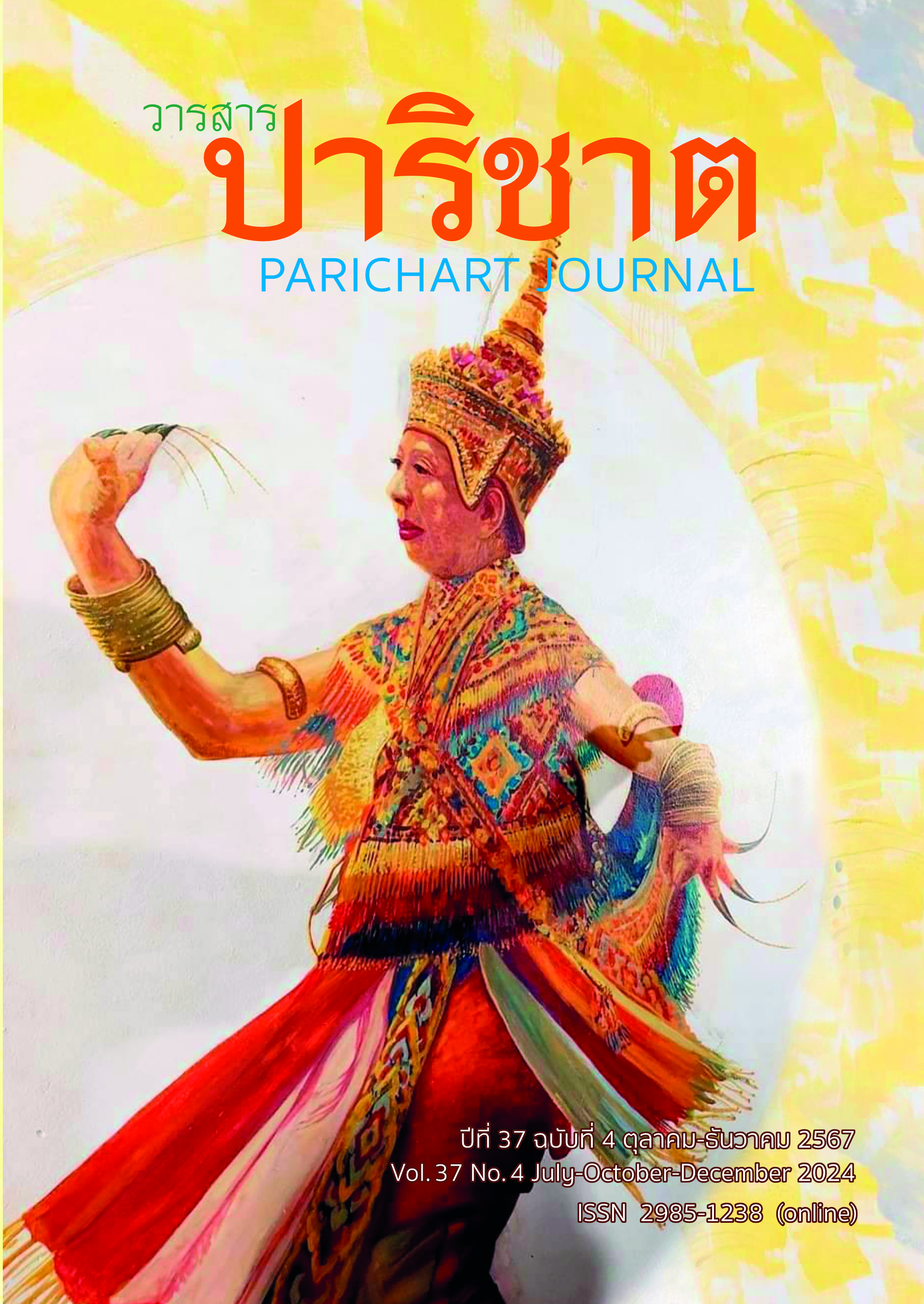Malaysian Tourist Loyalty towards Destinations in Hat Yai District, Songkhla Province
Main Article Content
Abstract
The objective of this study was to analyze the components and structural equation model of tourist loyalty in Hat Yai District, Songkhla Province. Hat Yai is currently a thriving city in the lower southern region of Thailand, known for its multicultural diversity, significant religious variety, and crucial transportation hub. These factors make Hat Yai a major destination for international tourists. The sample used in this study comprises 400 Malaysian tourists. Confirmatory factor analysis and Structural Equation Modeling (SEM) were employed in the analysis. The study's results indicated that the most substantial direct influence on tourist loyalty came from tourist satisfaction, with an effect size of 0.85. This is followed by the destination image, which had an effect size of 0.23. In terms of indirect effects, it was found that Malaysian tourist loyalty was indirectly influenced by tourist satisfaction through the destination image with an effect size of 0.78. The overall fit indices indicated that the model aligns well with the empirical data. The average variance extracted (AVE) values ranged from 0.70 to 0.76, while the composite reliability (CR) values ranged from 0.89 to 0.91 (Chi-square/df = 1.26, P-value = 0.12, RMSEA = 0.03, GFI = 0.98, AGFI = 0.97). Therefore, the government should implement policies to promote tourism by developing comprehensive tourism development plans and enhancing the diversity of tourism formats. This can be achieved by promoting the development of new tourist attractions and encouraging greater community involvement.
Article Details

This work is licensed under a Creative Commons Attribution-NonCommercial-NoDerivatives 4.0 International License.
References
Economics Academic Service Center Thammasat University. (2019). Proportion of value of creative industries for the year 2018. https://www.cea.or.th.
WTTC (2020). Travel and tourism- global economic impact and trends 2020. https://wttc.org/Research/
Abid, K., Bari, Y. A., Younas, M., Tahir Javaid, S., & Imran, A. (2020). Progress of COVID-19 epidemic in Pakistan. Asia Pacific Journal of Public Health, 32(4), 154-156. DOI: 10.1177/1010539520927259
Brodeur, A., Gray, D., Islam, A., & Bhuiyan, S. (2021). A literature review of the economics of COVID‐19. Journal of economic surveys, 35(4), 1007-1044. https://doi.org/10.1111/joes.12423
Greenstone, M., & Nigam, V. (2020). Does social distancing matter? University of Chicago, University of Chicago, Becker Friedman Institute for Economics Working Paper, 2020(26), 1-19. DOI:10.2139/ssrn.3561244
Thailand Development Research Institute. (2021, February 14). Analyzing the impact of covid-19 on the tourism business. https://tdri.or.th/2021/02/covid-112/
Saichumin, J., & Srinaruewan, P. (2023). Strategy and transformation for tourism entrepreneurs to compete in the market in the digital age [Master’s Thesis, Maejo University]. Maejo University Library. http://ir.mju.ac.th/dspace/handle/123456789/1662
Tourism Authority of Thailand. (2018). Thai tourism sees growth in line with the target. TAT news. https://www.tatnews.org/2018/12/thai-tourism-sees growth-in-line-with-the-target/
Klinthongchai, C., & Lakpech, P. (2018). Antecedents influencing the perceived destination competitiveness in the Andaman cluster for incentive travel using a Malaysian destination management company. Phuket Rajabhat University Academic Journal, 14(1), 103-118. http://webportal.pkru.ac.th/data_journals/
Fornell, C., & Larcker, D. F. (1981). Evaluating structural equation models with unobservable variables and measurement error. Journal of Marketing Research, 18(1), 39–50. https://journals.sagepub.com/doi/abs/10.1177/002224378101800104
Songkhla provincial agriculture and cooperatives office. (2023, February 6). Information on agriculture and cooperatives, Songkhla Province, Document No. 8/2023. https://www.opsmoac.go.th.
Hokta, D. (2020). Effects of tourism and recreation business marketing strategies on the loyalty of Thai tourists visiting Trang [Master’s Thesis, Raja Mangala University of Technology Srivijaya]. Research Information System, RMUTSV. https://riss.rmutsv.ac.th/upload/doc/202110/nZS0SKwMp2d iRiGaXj5W/nZS0SKwMp2diRiGaXj5W.pdf
Chermjorho, J. (2017). House brand value that affects customer loyalty in Mueang District, Nakhon Ratchasima Province [Master’s Thesis, Raja Mangala University of Technology Isan].
Saymany, T., & Nilplub, (2019). The effect of tourism image and satisfaction on tourist loyalty in Vientiane Capital, Lao People’s Democratic Republic. RMUTI JOURNAL Humanities and Social Sciences, 6(1), 126-141. https://www.researchgate.net/publication/
Ministry of Tourism & Sports. (2024, January 19). Tourism statistics for 2023. https://www.mots.go.th/
Papadimitriou, D., Kaplanidou, K. K., & Apostolopoulou, A. (2018). Destination image components and word-of-mouth intentions in urban tourism: A multigroup approach. Journal of hospitality & tourism research, 42(4), 503–527. DOI:10.1177/1096348015584443
Thummakriengkrai, W., & Assarut, N. (2020). Effect of travel motivation and tourist satisfaction on tourism information and experience sharing behavioral smartphone of foreign tourists in Thailand. Chulalongkorn Business Review, 42(2), 1-29. https://so01.tci-thaijo.org/index.php/CBSReview/
Monoarfa, H., Rahayu, A., Adirestuty, F., Abu Karim, R., Bahtar, A. Z., Ahmad Nazari, Z., & Mahmud, N. (2022). The influence of Islamic attributes on tourist satisfaction with pull motivation as an intervening variable. International Journal of Tourism Cities, 8(1), 140-152.https://doi.org/10.1108/IJTC-02-2021-0033
Choosuwan, N., & Sakulkijkarn, W. (2023). Integrated marketing communication, service quality, and tourism motivation influencing decision-making and loyalty of tourists using accommodations in Koh Larn, Chonburi Province. Journal of KMITL Business School, 13(1), 1-16. http://ir-thesis.swu.ac.th/dspace/handle/123456789/2080
Christina Geng-Qing Chia, b., & Li Panc, G. D. C. (2018). Examining destination personality: Its antecedents and outcomes. Journal of Destination Marketing & Management, 9(3), 149-159. https://doi.org/10.1016/j.jdmm.2018.01.001
Tangcharoensopon, A., Wongchawalitkul, B., & Saengsuwan, T. (2020). Structural equation model of Thai tourist loyalty towards destinations in northeastern Thailand. Community Journal, 14(2), 174-188. https://so05.tci-thaijo.org/index.php/sjss/article/view/246192
Dabpetch, S. (2023). Testing a hierarchical travel constraints model of Thai tourists’ family life cycle within the context of heritage destinations. Journal of Business Management Burapha University, 12(1), 1-25. https://ojs.lib.buu.ac.th/index.php/business/article/view/8697
Jaroenkrityawuth, S., Tawattana-Pradit, P., Anusasnanun, S., & Donmuang, P. (2019). Cluster analysis of problem-solving and overcoming obstacles of vocational students. Journal of Education, MMRU, 7(2), 571-581. http://ojs.mbu.ac.th/index.php/edj/article/view/718
Somchob, P. (2017). Marketing communication strategy model to attract tourism in Ubon Ratchathani Province. Ubon Ratchathani Journal of Research and Evaluation, 6(1), 29-38. https://so06.tci-thaijo.org/index.php/ubonreseva/article/view/251031
Muangmee, C., Soonsawad, N., Kijrrrungroijarean, P., Panyasupat, R., & Bunuam, R. (2019). Tourist loyalty model towards tourist attractions in Samut Songkhram Province. Journal of Humanities and Social Sciences Thonburi University, 13(2), 125-137. https://so03.tci-thaijo.org/index.php/trujournal/article/view/192733
Pradjuab, M., & Chuwong, N. (2022). Causal factors influencing behavioral intention towards Red Lotus Sea tourism. Journal of Management Sciences Udon Thani Rajabhat University, 4(3), 101-115. https://so08.tci-thaijo.org/index.php/MSJournal/article/view/2847
Kasikorn Research Center. (2023). Business analysis. https://www.kasikornresearch.com


